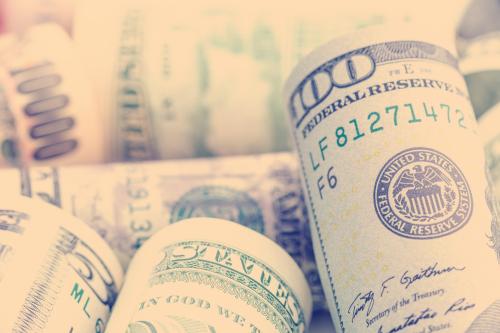The U.S. Treasury is using its Exchange Stabilization Fund during the coronavirus crisis to backstop new Federal Reserve lending programs aimed at stabilizing credit and money markets. Here’s how it works.
What is the Exchange Stabilization Fund?
In general, the Secretary of the Treasury can only spend money that has been appropriated by Congress. But with the consent of the President, the Secretary has substantial leeway to use the money in the Exchange Stabilization Fund (ESF) that Congress created in the Gold Reserve Act in 1934. The Act established the ESF as a reserve to stabilize the U.S. dollar in case of turmoil in foreign currency markets after the U.S. abandoned the gold standard. But over time, Treasury has mostly used it lend to other economies on the brink of default—for example, to stabilize Mexican government debt in the 1994 peso crisis. As amended in the late 1970s, the Act provides that “the Secretary…with the approval of the President, may deal in gold, foreign exchange, and other instruments of credit and securities.” As of the end of February 2020, the ESF held $93.7 billion in U.S. dollars, euros, Japanese yen, and Special Drawing Rights, an international reserve asset created by the IMF. From time to time, and even in the current crisis, some members of Congress have proposed to limit the Treasury secretary’s ability to tap what they call a “slush fund.”
How has the ESF been used in the coronavirus crisis?
The Treasury is using the ESF as a backstop to cover any losses the Federal Reserve may incur through lending programs created to cope with the crisis. In general, when the Fed lends money to banks and other financial institutions, it wants to be sure it’ll be paid back and insists on collateral, usually in the form of very safe assets like U.S. Treasury debt. In periods of financial turmoil like the 2008 financial crisis and the present crisis, however, the Fed can help stabilize markets by accepting a broader range of assets as collateral for loans to financial institutions. In doing so, it encourages banks to keep lending to businesses and consumers by guaranteeing that they can exchange the resulting assets for cash at the Fed, if necessary. In March 2020, the Fed has created or re-opened programs to accept as collateral money market fund assets, corporate bonds and loans, municipal bonds, and securities backed by consumer and small business loans. The Treasury promised the Fed $50 billion out of the ESF to cover any losses in these new lending programs.
For details on the Fed’s lending programs, click here.
Are taxpayers paying for the Fed’s emergency lending?
By providing funds from the ESF, the Treasury is agreeing to cover losses on the Fed’s emergency lending. If there are losses, the taxpayers are on the hook. During the 2008 financial crisis, the Fed experienced no losses on individual loans made under its emergency programs. In fact, the Fed earned an estimated $20 billion in interest and fees on the loans and remitted those profits to the Treasury.
Are there any limits on what the Fed can do?
The backstop the Treasury has provided to the Fed will allow it to lend a lot of money, but not as much as it lent during the global financial crisis of 2007-09 when it could, through the Treasury, tap money Congress appropriated for the Troubled Asset Relief Program (TARP). Since more than half of the ESF’s $93.7 billion balance has already been pledged to backstop Fed lending, any major expansion of those facilities will likely require action from Congress to devote more taxpayer money to the effort. Legislation pending in Congress would do just that.
Has anything like this been done before?
In 2008, during the worst of the financial crisis, the Treasury used funds from the ESF to temporarily guarantee deposits in certain money market mutual funds. Ultimately, none of the money market funds defaulted, and so the ESF had no losses from the program. In fact, the program earned about $1.2 billion from fees. Congress subsequently forbid the use of the ESF for this purpose. Treasury Secretary Steven Mnuchin has asked Congress to lift that ban during the coronavirus crisis.
Several of the emergency lending programs that the Fed has launched in response to the coronavirus resemble those created during the 2008 financial crisis. But at the time, none of these were backed by the ESF. Backstop funds for the 2008 Term Asset-Backed Securities Loan Facility, for example, were provided by Congress as part of TARP.
Prior to the 2008 crisis, the Treasury most often used the ESF to finance short term loans to emerging market countries facing currency or debt crises. In 1994, for example, the Treasury agreed to lend up to $20 billion from the ESF to Mexico to help it stabilize the peso after Congress refused President Bill Clinton’s request to appropriate money for Mexico. Mexico borrowed $12 billion, which it paid back, and the U.S. made a $500 million profit. During the Asian financial crisis in 1997, the U.S. offered $3 billion for Indonesia and $5 billion for South Korea from the ESF. Neither country used the loan, in the end. In 2002, Uruguay borrowed $1.5 billion. The loan was repaid in full to the Treasury.







Commentary
What is the Exchange Stabilization Fund? And how is it being used in the coronavirus (COVID-19) crisis?
March 24, 2020